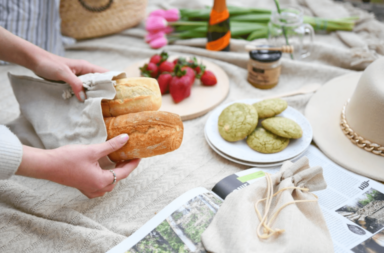Preparing food at home and taking it with you to work or on a trip is not only a way to eat healthily and save money, but also to protect the environment. When eating out, using food trucks or ordering takeaways, we have to face high bills and also be aware that we may be given disposable cutlery, plates, straws and packaging. If you want to take care of what you eat, boost your household budget and contribute to the environment, swap your lunch out on the town for a lunchbox. Such a change requires good organisation, so check out what you will need!
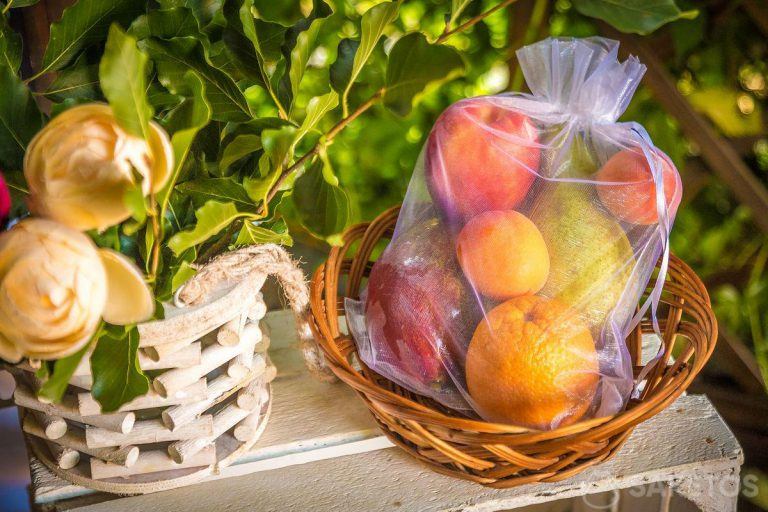
Organza bag as an alternative to a fruit net
Lunchbox – essential equipment
If you’re opting for a lunchbox, you’re probably looking to reduce waste and boost your budget. You can achieve both by opting for reusable products that can last for years. Pay attention to the material, which should be easy to clean and suitable for food storage. You can take some of the products you need from home (e.g. cutlery) and buy others – a small one-off expense.
Lunchbox
Breakfast boxes used to be king in Polish schools, which have now been replaced by more practical lunchboxes. These are airtight boxes divided into convenient compartments. So you don’t have to worry about fruit getting mixed up with vegetables or yoghurt – everything has its place in the lunchbox. You can find lunchboxes on sale in various sizes, colours and shapes. You can also find special lunchboxes with a heating function, so you can easily have a warm meal at work. Another option is to choose a standard lunchbox that is suitable for heating in the microwave.
Lunchpot
An alternative to the classic lunchbox is the lunchpot, a breakfast container that is shaped more like a cup. The lunchpot takes up less space and usually consists of two containers: a larger lower one and a smaller upper one. Choose it if you like to eat yoghurt with fruit and muesli and don’t want to mix all the ingredients a few hours before consumption. The lunchpot will also work well for dishes such as soup with croutons or pasta with sauce.
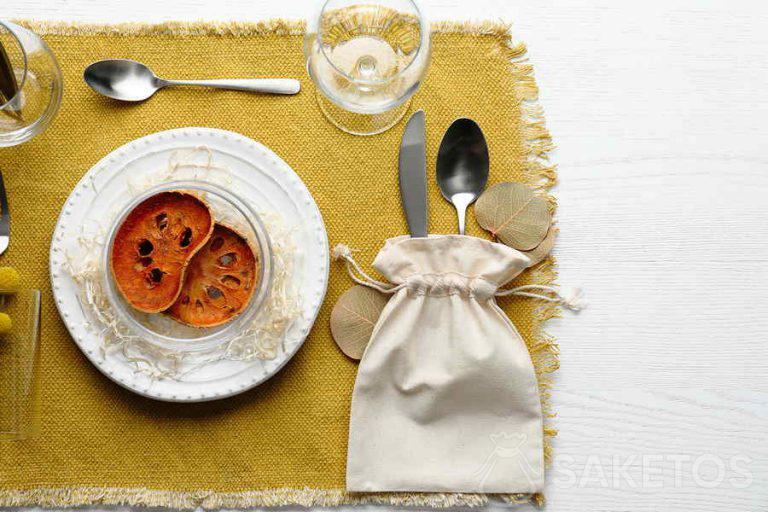
A fabric bag for cutlery will make it easier to take food on a summer picnic
Water bottle
Poles buy up to 4.5 billion plastic bottles every year. However, more and more people are opting for a filter jug or a reusable bottle (some with filters are also available) to take with them on the go. You can, of course, pour not only water into the bottle, but also juice or smoothies. There really are a lot of options to choose from– from small 200 ml bottles to 2 litre bidons. Adapt the capacity to your needs and dispense with disposable bottles altogether.
Coffee and tea mug
Are you able to give up your lunch out on the town, but can’t resist a visit to your favourite coffee shop? If you often take coffee to go, stock up on a reusable mug. It’s worth opting for a silicone folding mug, which takes up little space so you can always carry it with you. Did you know that some cafés reward people who bring their own cups with a discount? It really is worth it!
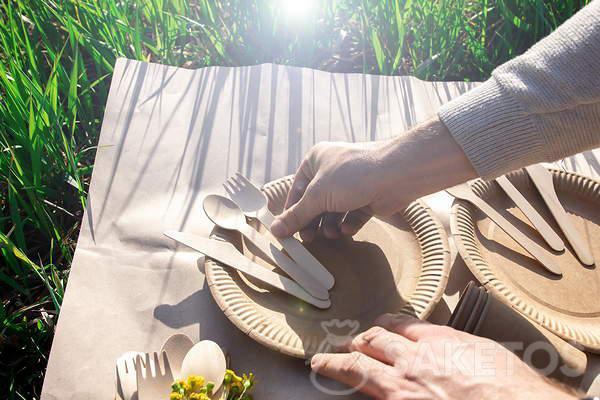
Eco tableware is ideal for a lunchbox for work or a picnic
Cutlery and accessories
A lunchbox cannot, of course, lack cutlery. It is best to opt for classic stainless steel forks, knives, spoons and spoons that you can take from your own drawer. We strongly discourage disposables, especially wooden ones, as they have to be thrown away after use. Storage of cutlery is also important – for this you can use practical cutlery pouches made of linen or cotton. Such a cutlery pouch should be made of natural and uncoloured material that is washable. Drawn with a drawstring, it will protect our breakfast accessories in a handbag or backpack. The cutlery bag can be carried with you at all times – it will also come in handy for an unplanned lunch out on the town, for which we will not need to take disposable cutlery.
How do I create a healthy lunchbox?
When preparing a meal at home, you have 100 % control over what goes into it. It is worth going beyond the sandwich scheme and start composing wholesome meals yourself. Make sure you have plenty of variety and experiment with the composition of your lunchbox!
Examples of ingredients:
- oatmeal cooked with water or milk,
- salad with vegetables, protein (e.g. lentils) and healthy fats (e.g. vegetable oil, fish),
- pancakes with vegetables,
- courgette pancakes,
- pasta with pesto peas and vegetables,
- whole-grain bread,
- tortilla with vegetables and chicken,
- healthy snacks: carrots, celery, peppers, nuts, nuts and nuts.
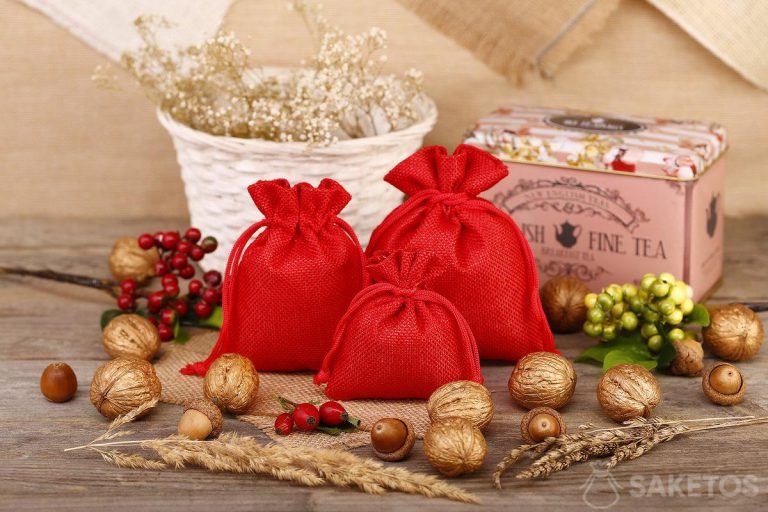
Red jute bags are great for storing nuts and nuts
Lunchboxes in Japan and Scandinavia
Lunchboxes are popular not only in Poland, but also in other countries. Lunchboxes probably originated in Japan, where they appeared as early as the Edo period (between 1600 and 1863). The Japanese took them with them on hunting trips and to work, and their containers usually contained dried rice that was combined with water. The Japanese lunchbox is called a bento or obento and is popular with both children and adults. The careful preparation of bento for a child is a sign of parental care and love. The Japanese take great care not only of the taste, but also of the appearance of the bento – the lunch is often formed in such a way that the composition resembles animals, plants or the seasons.
Lunchboxes are also popular in Scandinavia, where they are found under the name matpakke. The tradition dates back to the 1930s, when one free meal for schoolchildren per day was introduced. However, when Norway started to become richer, parents could afford to prepare the meals themselves. Today, matpakke are imaginative lunches for children and adults. In many Norwegian lunchboxes, you will find sandwiches that differ from the Polish ones – in Scandinavia, you do not put two slices together, but prepare a slice with pålegg (this is the word for all the ingredients on the sandwich) and then cover it with breakfast paper, on which another slice lands.
You already know how to compose a healthy lunchbox for work and what products you will need to complete your breakfast set. Get inspired and make positive changes to your everyday life!

